Market forces are rapidly driving big changes in housing systems for pregnant sows. Pork producers are wondering how to successfully transition from gestation stalls to penned gestation systems within the confines of existing buildings. This general question was posed by a 5,000-sow, commercial, farrow-to-wean pig producer in North Dakota. Specifically, the producer asked how to retrofit their gestation barn from stalls to pens without changing sow inventory, and what the consequences of such a change would be. While there are many issues that could be studied related to this transition, University of Minnesota researchers chose pen size as the primary issue to consider.
August 15, 2012

Market forces are rapidly driving big changes in housing systems for pregnant sows. Pork producers are wondering how to successfully transition from gestation stalls to penned gestation systems within the confines of existing buildings.
This general question was posed by a 5,000-sow, commercial, farrow-to-wean pig producer in North Dakota. Specifically, the producer asked how to retrofit their gestation barn from stalls to pens without changing sow inventory, and what the consequences of such a change would be.
While there are many issues that could be studied related to this transition, University of Minnesota researchers chose pen size as the primary issue to consider. Typically, sows housed in pens are allotted more floor space than sows housed in individual stalls. But in this field study, the underlying question was whether all the current gestating sows in this unit could be housed in pens using the existing building’s footprint.
Field Study Design
The study, including records on 815 sows, Parities 1-8, was conducted from February 2010 through May 2011. No Parity 0 females (gilts) were included in the study.
All sows were weaned into stalls, inseminated, and remained in stalls until confirmed pregnant by ultrasound at about 35 days post-mating. Sows confirmed pregnant formed a contemporary group and were placed in gestation stalls or gestation pens, where they remained until about Day 109 of gestation, when they were moved to farrowing crates.
Every four to six weeks, sows from one contemporary breeding group were moved to either one large pen, two small pens or 25 gestation stalls.
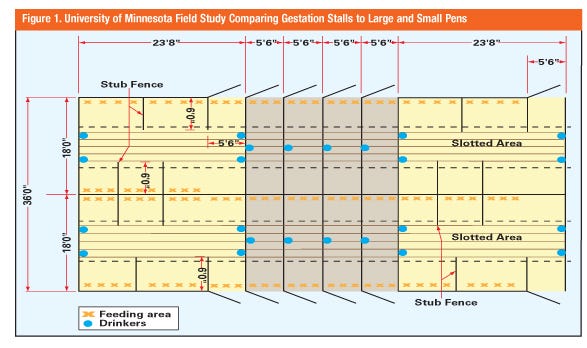
The large pens measured 18 x 23.8 ft. and housed 26 sows (Figure 1). Large pens were constructed by removing two rows of 13 gestation stalls that were oriented “butt-to-butt.” The recessed feeding trough was filled with concrete, and four “stub” fences were fitted in each large pen. The purpose of the stub fences was to provide a place for submissive sows to escape aggression and divide the feeding area into smaller sections. Feed drops from the two rows of 13 gestation stalls remained and dropped feed on the floor where the feed trough was located.
Small pens measured 18 x 5.5 ft. and housed six sows each. Small pens were constructed exactly the same as the large pens, except two rows of three gestation stalls were removed and no stub fences were installed.
Existing gestation stalls in the barn measured 22 in. x 7 ft. and served as the control treatment in the study.
Large pens were equipped with four nipple drinkers; small pens had one nipple drinker. All pens had an 88-in.-wide area of concrete slats down the center of the pens with equal amounts of solid floor on either side.
These conversions used floor space from the gestation stalls, plus the alleyway between the two rows of stalls that were removed. Both large and small pens provided 16.5 sq. ft. of floor space per sow.
Sows in small pens were sorted visually, by size, with small sows and large sows being housed in different pens. Small sows were usually younger (Parity 1-4), while large sows ranged from Parity 1 through 8. This sorting occurred to reduce the potential for large sows abusing small sows in the tight confines of the small pens. Sows in large pens were not sorted. All small pens, regardless of sow size, were considered together in summary and analysis of data.
The study commenced when sows were allocated into pens or stalls after pregnancy confirmation and ended after sows farrowed and weaned one litter and were mated for the next pregnancy. Facility constraints prevented keeping sows in their assigned gestation housing system for multiple parities.
Sows in pens and stalls were provided the same amount of feed daily — 5.5 lb./sow. Feed was delivered twice daily with an equal amount at about 6 a.m. and 12 p.m. In pens, feed was dropped on the solid portion of the floor from the existing feeder lines. Each sow had a feed pile dropped.
Sows were weighed when moved into gestation pens or stalls, weighed again when they moved to farrowing crates, and again at weaning. All performance data for each sow was captured from the farm’s existing computerized recordkeeping system.
All injuries to animal care workers that occurred during the study were recorded. Workers also recorded time spent to vaccinate sows, treat sick sows, move sows, and remove dead or culled sows from each housing system.
A total of 13 contemporary groups were documented over the 15-month study period, with 338 sows in 13 large pens, 156 sows in 26 small pens, and 325 sows in stalls serving as controls.
Sow Performance
There were small but statistically significant differences in body weight of sows at the beginning of the study, which are reflected in sow weight at weaning (Table 1).
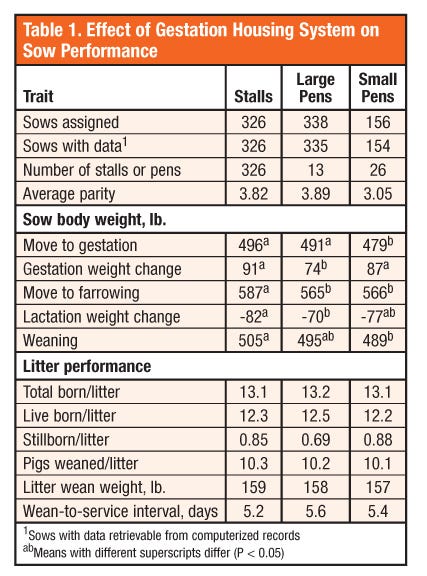
Throughout the study, sows in stalls gained 9 lb., while sows in large and small pens gained 4 lb. and 10 lb., respectively. For sows that farrowed a litter, there were no differences in number of pigs farrowed or weaned per litter, litter weight at weaning or wean-to-mating interval among the three housing treatments.
In contrast to litter performance data, differences in the proportion of sows that did not complete the experimental period across the three housing systems are noteworthy (Table 2). During the study period, 9% of the sows in stalls were removed, but 16% of sows in large pens and 12% of sows in small pens failed to complete the study.
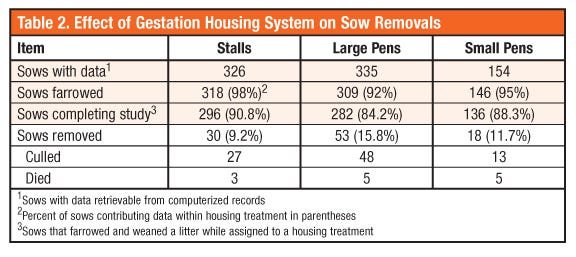
Among all the removed sows, a greater percentage of sows were culled from large pens (14.3%) compared with small pens (8.4%) and stalls (8.3%). However, more sows died in small pens (3.2%) compared with large pens (1.5%) or stalls (0.6%).
No consistent pattern of removals related to sow parity was observed. In fact, there were no significant interactions between sow parity and housing treatment in this study, which suggests that sows of all parities responded similarly to housing treatments.
The reasons for culling were different for sows in stalls vs. sows in pens (Table 3). In stalls, poor reproductive performance was the main reason for culling, whereas injuries caused by fighting and poor body condition were major reasons for culling sows in pens. When comparing pen size, more sows were culled due to injuries in large pens, but a higher proportion of sows in small pens were culled for poor body condition. A higher proportion of sows died or had to be euthanatized in small pens compared to large pens. Obviously, this is an added cost of the system because there is no salvage value for sows that were removed.
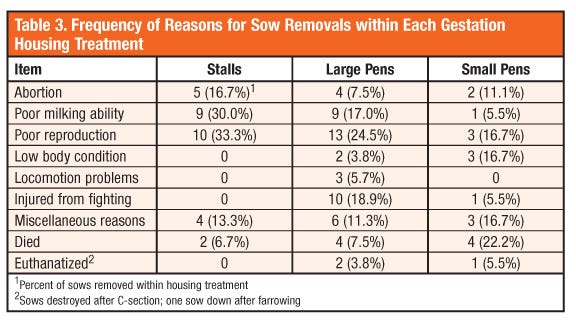
Finally, housing system had no effect on the health of workers or the incidence of worker injuries. During the course of this study, there were no injuries to workers recorded in any of the housing systems studied.
Barn staff recorded the number of people and the time required to move and sort sows, vaccinate sows, treat sick sows and remove dead sows. Total labor requirements expressed as “minutes/sow space” during the 74 days sows were housed in each system for this study were 3.1 minutes for stalls, 6.1 minutes for large pens and 10.1 minutes for small pens.
The relatively higher labor requirement in small pens vs. large pens was surprising. Barn staff noted that vaccinating and sorting sows was harder in the small pens because there was not sufficient space to move sows around, making it more difficult to vaccinate the last couple of sows in the pen.
Economic Considerations
Litter size farrowed and weaned was not affected by gestation housing system in this study. Therefore, the economic impact of the gestation housing systems is driven by the increased fallout rate of sows in pens and the additional labor required to manage sows in pens (Table 4). This economic analysis is patterned after the conditions of the study farm.
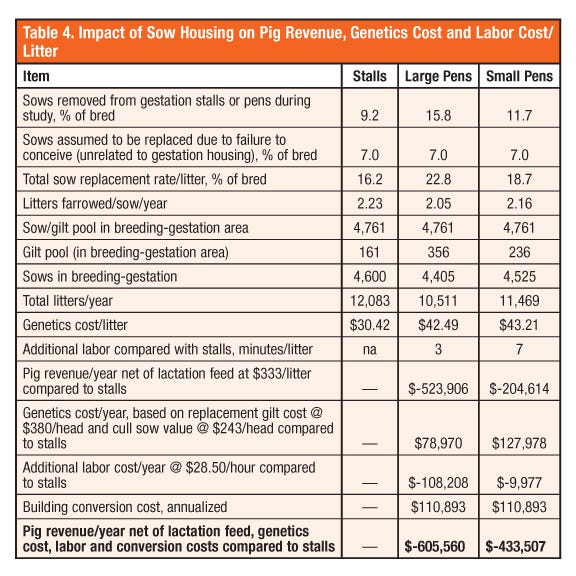
The total sow replacement rate per litter ranged from 16.2 to 22.8%, if one assumes a standard 93% conception rate (mating to Day 35, post-insemination) from the farm’s records and the removal rate of sows in the three gestation housing systems.
The economic outcomes of the gestation housing systems were calculated using the constraints provided by the producer cooperator. Their primary constraint was that the number of breeding-gestation spaces is fixed, so the sow herd would have to fit within the existing unit. Given this constraint and the increased fallout rate in large and small pens, the gilt pool for those penning systems must be larger than for the stall system.
The fixed breeding-gestation spaces mean that replacement gilts will occupy more spaces, thus displacing productive sows. This constraint leads to poorer utilization of the existing farrowing facilities and 5 to 13% fewer litters produced annually. The higher removal rate of sows in the penned systems leads to a 21 to 35% higher cost for genetics.
The additional labor required for managing sows in pens compared with stalls also increases costs to produce a litter of weaned pigs. Using a labor cost of $28.50/hour derived from farms in the University of Minnesota’s FINBIN farm business summary database, labor costs per litter increase about $1.40 to $3.30. However, the reduced litters mean that the total farm labor cost declines by 1 to 11%.
The actual cost of retrofitting the gestation barn with pens for this research is not considered here because the small number of stalls converted would not be a fair indicator of the cost of converting an entire barn.
In a May 2010 paper, “Economic Impact of Transitioning from Gestation Stalls to Group Pen Housing in the U.S. Pork Industry” (http://purl.umn.edu/61604), University of Minnesota Agricultural Economist Brian Buhr estimated that retrofitting a gestation barn with pens would cost $185/sow space. Perhaps the simplest way to express the net impact on the field trial farm’s profitability is as a percent of annual gross pig revenue, which would be around $4.8 million, assuming a value of $40/pig and 10 pigs weaned/litter. The reduced litters and increased costs for genetics, labor and the conversion to pens would amount to a financial loss of $433,507 (small pens) to $605,560 (large pens), or 9 to 13% of the gross revenue, respectively.
The Buhr paper also points out that pork market prices and quantities would likely be affected by an industry-wide shift to group sow housing in the United States. Competition from beef, chicken and imported pork would prevent pork prices from adjusting sufficiently to completely compensate pork producers for the increased cost of group housing, but most of the cost would be shifted to consumers.
Cautious Insights
This study provides some important insights into the transition from housing gestating sows in stalls vs. pens, in a real-world commercial setting. However, one should use caution in interpreting the results.
The economic calculations assumed comparable removal rates would occur in subsequent reproductive cycles. However, sows were only studied for one reproductive cycle, so it cannot be said with certainty what the removal rates will be as sows return to these housing systems.
The floor space allowance for sows in this study was only 16.5 sq. ft./sow, which is about 20 to 25% less than typical recommendations for housing gestating sows in pens. Therefore, extrapolation of the results to housing systems with more space for sows should be done cautiously. It was noted that the low floor space allowance was particularly problematic in the small pens because dominant sows could monopolize the feeding areas more completely than in the large pens.
Certainly, the industry will continue to grapple with the implications of a transition in housing for gestating sows in the foreseeable future. As more experience is gained under varying conditions, a more ideal group housing system will emerge.
*About the Authors: Lee J. Johnston, swine nutrition and management specialist, and Yuzhi Li, assistant professor, swine production systems, are located at the University of Minnesota West Central Research and Outreach Center, Morris, MN; William F. Lazarus, Extension economist, is located at the University of Minnesota, St. Paul, MN.
You May Also Like



